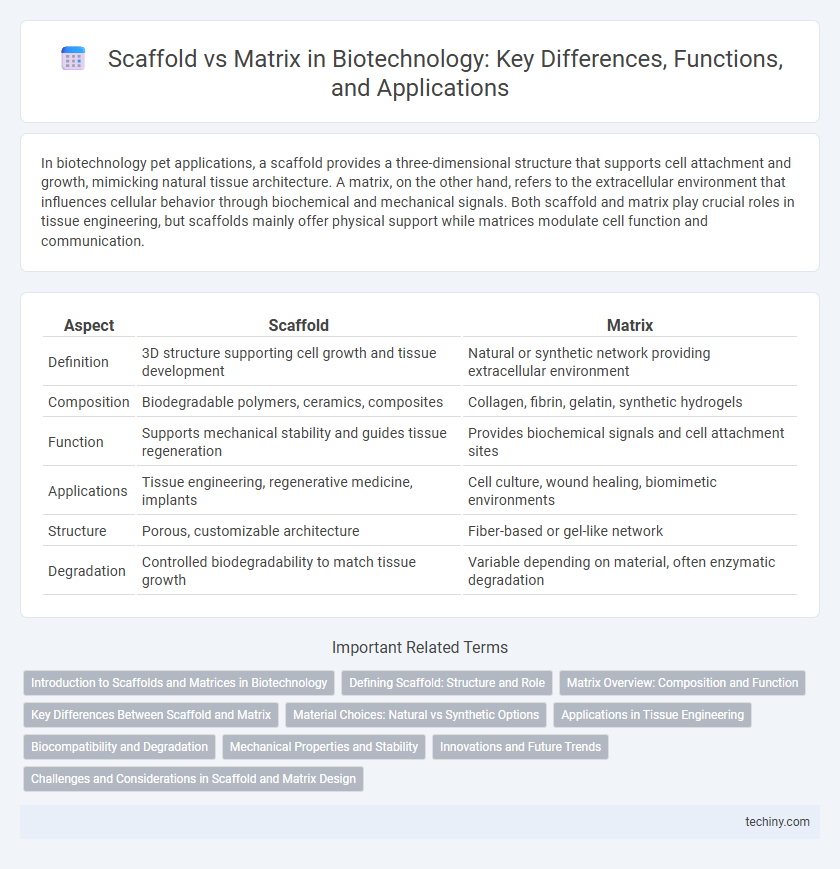In biotechnology pet applications, a scaffold provides a three-dimensional structure that supports cell attachment and growth, mimicking natural tissue architecture. A matrix, on the other hand, refers to the extracellular environment that influences cellular behavior through biochemical and mechanical signals. Both scaffold and matrix play crucial roles in tissue engineering, but scaffolds mainly offer physical support while matrices modulate cell function and communication.
Table of Comparison
| Aspect | Scaffold | Matrix |
|---|---|---|
| Definition | 3D structure supporting cell growth and tissue development | Natural or synthetic network providing extracellular environment |
| Composition | Biodegradable polymers, ceramics, composites | Collagen, fibrin, gelatin, synthetic hydrogels |
| Function | Supports mechanical stability and guides tissue regeneration | Provides biochemical signals and cell attachment sites |
| Applications | Tissue engineering, regenerative medicine, implants | Cell culture, wound healing, biomimetic environments |
| Structure | Porous, customizable architecture | Fiber-based or gel-like network |
| Degradation | Controlled biodegradability to match tissue growth | Variable depending on material, often enzymatic degradation |
Introduction to Scaffolds and Matrices in Biotechnology
Scaffolds and matrices serve as critical frameworks in biotechnology, providing structural support for cell attachment, growth, and tissue regeneration. Scaffolds are typically three-dimensional porous structures designed to mimic the extracellular matrix, facilitating nutrient diffusion and cellular communication. Matrices refer broadly to the environment surrounding cells, often consisting of natural or synthetic biomaterials that influence cell behavior and tissue development.
Defining Scaffold: Structure and Role
A scaffold in biotechnology refers to a three-dimensional framework designed to support cell attachment, growth, and differentiation, mimicking the natural extracellular environment. It provides structural integrity and promotes tissue regeneration by facilitating nutrient diffusion and waste removal. Key materials for scaffolds include biocompatible polymers such as collagen, polylactic acid, and hydroxyapatite, which influence mechanical strength and biodegradability.
Matrix Overview: Composition and Function
In biotechnology, a matrix primarily serves as a three-dimensional scaffold composed of natural or synthetic polymers like collagen, fibrin, and hyaluronic acid to support cellular growth and tissue development. This extracellular matrix mimics the native cellular microenvironment by providing structural integrity, regulating cell behavior, and facilitating nutrient diffusion. Matrix composition critically influences cell adhesion, proliferation, and differentiation, making it essential for successful tissue engineering applications.
Key Differences Between Scaffold and Matrix
Scaffolds in biotechnology are three-dimensional structures designed to support cell attachment and tissue formation, often made from biocompatible materials like polymers or ceramics. Matrices refer to the extracellular environment or synthetic substrates that provide biochemical and mechanical cues crucial for cell adhesion, proliferation, and differentiation. The key difference lies in scaffolds serving primarily as physical frameworks for tissue engineering, while matrices encompass a broader role including biochemical signaling and interaction within the cellular microenvironment.
Material Choices: Natural vs Synthetic Options
Scaffold materials in biotechnology can be natural, such as collagen and chitosan, offering excellent biocompatibility and bioactivity, or synthetic, like polylactic acid (PLA) and polyethylene glycol (PEG), providing controlled mechanical strength and degradation rates. Matrices often utilize natural polymers including gelatin and alginate for cell encapsulation and signaling, whereas synthetic matrices employ hydrogels and biodegradable polymers tailored for specific tissue engineering applications. Selecting between natural and synthetic materials depends on desired properties like cellular interaction, structural integrity, and customization in regenerative medicine.
Applications in Tissue Engineering
Scaffolds provide a three-dimensional framework essential for cell attachment, proliferation, and differentiation in tissue engineering, facilitating the regeneration of complex tissues such as bone, cartilage, and skin. Matrices serve as bioactive environments rich in extracellular components that support cellular signaling and integration, enhancing tissue repair and functional recovery. Both scaffolds and matrices are critical in designing biomaterials that mimic native tissue architecture and biochemical properties for successful tissue regeneration applications.
Biocompatibility and Degradation
Scaffolds in biotechnology often exhibit tailored biocompatibility by incorporating materials such as collagen or synthetic polymers that minimize immune response and support cell adhesion, whereas matrices typically consist of extracellular matrix components like laminin or fibronectin that inherently promote cellular integration. Degradation rates vary significantly between scaffolds and matrices; scaffolds can be engineered for controlled biodegradation through polymers like polylactic acid (PLA), ensuring gradual resorption aligned with tissue regeneration. Matrices usually degrade enzymatically via matrix metalloproteinases (MMPs), facilitating natural remodeling but often with less predictable kinetics, impacting tissue engineering outcomes.
Mechanical Properties and Stability
Scaffolds in biotechnology provide controlled mechanical properties essential for tissue regeneration, offering tailored stiffness, elasticity, and durability to support cellular growth. Matrices generally exhibit inherent mechanical stability derived from their natural extracellular components, promoting biocompatibility but often lacking customizable mechanical strength. Comparative analysis reveals that engineered scaffolds surpass traditional matrices in mechanical robustness and structural integrity, crucial for load-bearing tissue applications.
Innovations and Future Trends
Innovations in scaffold design leverage biomimetic materials and 3D bioprinting technology to enhance cellular growth and tissue integration, outperforming traditional matrix systems. Future trends emphasize smart scaffolds embedded with sensors and drug delivery capabilities to enable real-time monitoring and controlled tissue regeneration. Advances in nanotechnology and bioactive materials are driving the development of customizable scaffolds tailored to specific patient needs and complex tissue architectures.
Challenges and Considerations in Scaffold and Matrix Design
Scaffold and matrix design in biotechnology face challenges including biocompatibility, mechanical strength, and biodegradability tailored to specific tissue engineering applications. Considerations involve optimizing pore size, structure, and material composition to facilitate cell adhesion, proliferation, and differentiation while minimizing immune response. Ensuring uniform nutrient diffusion and waste removal remains critical for maintaining cell viability throughout scaffold or matrix integration.
Scaffold vs Matrix Infographic

 techiny.com
techiny.com